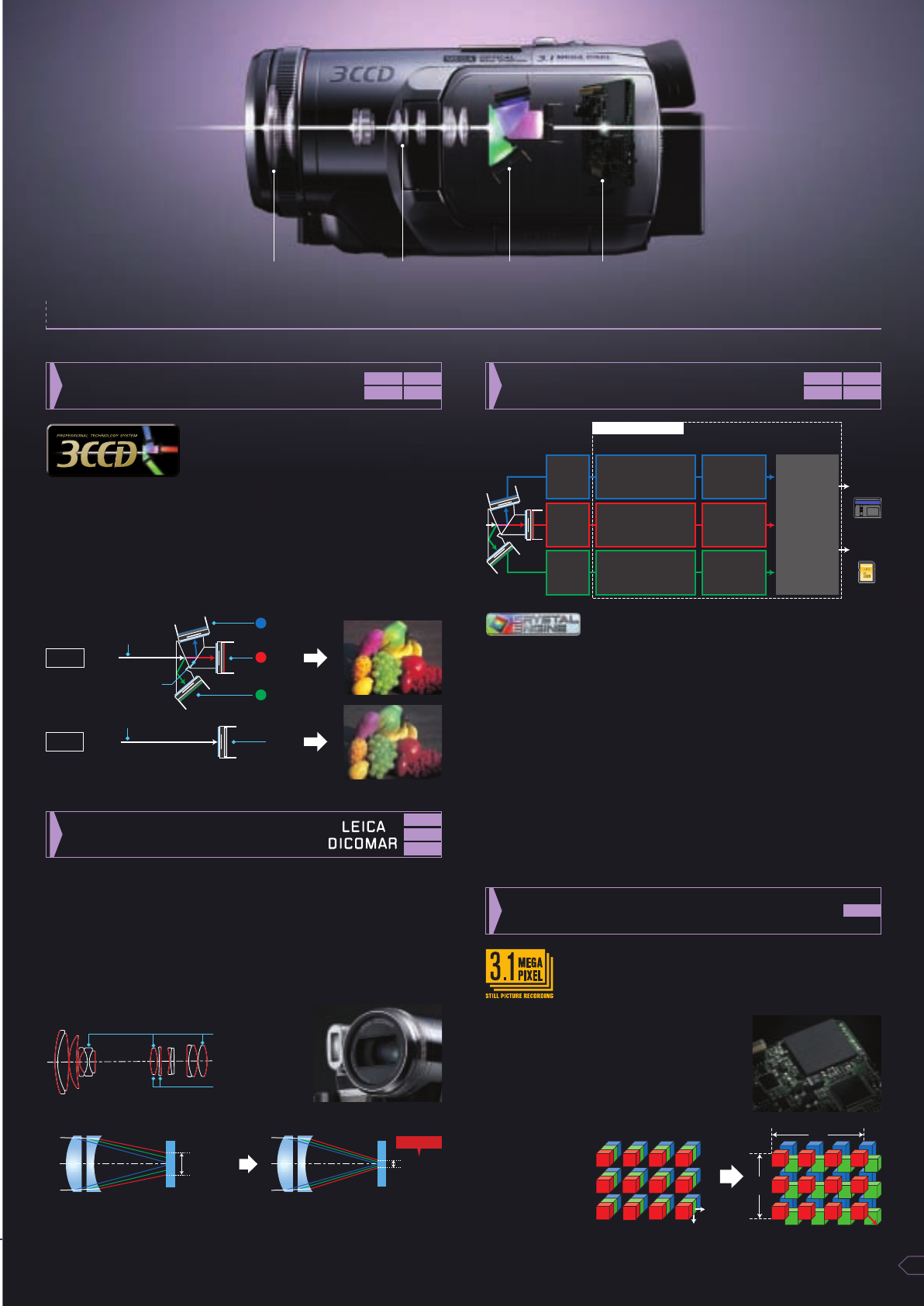
Conventional Lens
•
Low-Dispersion Glass (GS250)
•
14 Multi-Coated Lens Surfaces (GS250)
New Lens
Chromatic
Aberration
Chromatic
Aberration
Light
Light
Aspherical Lenses
O.I.S. Lenses
Approx. 1/3
3CCD
1CCD
CCD
CCD
Optical Axis
Optical Axis
Dichroic Mirrors
G
CCD
R
CCD
B
The camera's CCD (charge-coupled device) plays a
critical role in picture quality. That's why Panasonic
chose a 3CCD camera system – the type used in
professional video cameras. In this advanced system
the incident light is split into its three primary colour
components (red, green and blue), and the resulting signal from each is collected
by one of the three CCDs. The GS250’s 3CCD system features a total of 800,000
pixels times 3. It captures moving pictures with an effective 630,000 pixels times 3
and still pictures with an effective 710,000 pixels times 3, which provides highly
detailed colour information. Compared with conventional 1CCD camera systems,
Panasonic's advanced 3CCD system gives you greater beauty three different ways:
in colour, detail, and gradation.
Leica is renowned by photographers everywhere as a maker of superb cameras
and lenses. Now this legendary optical technology fuses with Panasonic's advanced
digital technology in the Leica Dicomar lens. The GS250's brilliant new lens features 13
lens elements in 9 groups and uses low-dispersion optical glass to reduce chromatic
aberration to about 1/3 the level of conventional lenses. A special multi-coating
process is applied to 14 lens surfaces, minimising harmful reflection to deliver crisp,
clear images free of flare and ghosting.
*Leica is a registered trademark of Leica Microsystem IR GmbH, and Dicomar is a registered
trademark of Leica Camera AG.
Analogue
Signal
Processor
Noise-Shaping Filter
2D RGB Noise Reduction
3D RGB Frame
Noise Reduction
Advanced Pixel
Interpolation
System (AXIS)
Analogue
Signal
Processor
Noise-Shaping Filter
2D RGB Noise Reduction
3D RGB Frame
Noise Reduction
Advanced Pixel
Interpolation
System (AXIS)
Analogue
Signal
Processor
Noise-Shaping Filter
2D RGB Noise Reduction
3D RGB Frame
Noise Reduction
Advanced Pixel
Interpolation
System (AXIS)
Moving-Picture
Circuit
Still-Picture
Circuit
Detail, Contrast
and Colour
CorrectionReduces Noise
Pixel
Interpolation
Crystal Engine
Moving-
Pictures
Still-
Pictures
3D RGB Frame Noise Reduction
The noise reduction system uses a noise-shaping filter (first
dimension) to remove the rough, highly visible noise. Next, it extracts and analyses data from
several adjacent pixels in the horizontal and vertical directions (second dimension), and removes
any parts that it determines to be noise. Finally, the process is applied to the time axis (third
dimension), where it extracts and analyses several frames, and again removes parts that it
determines to be noise. The result is a better noise-reduction performance than conventional
systems provide. The noise reduction is particularly effective when shooting at low illumination,
so you can capture clear, sharp images even at night or when lights are low.
AXIS (Advanced Pixel Interpolation System)
Quad-Density Pixel Distribution technology improves image precision by interpolating the signal
for areas on the CCD where there are no pixels. AXIS helps reproduce even finely detailed
portions of an image, giving the picture a higher-resolution appearance.
Digital Signal Processing
This new configuration consists of two separate image processing circuits, one for moving
pictures, one for still pictures. Using the optimum circuit for each type of picture makes it
possible to record both with outstanding quality.
Leica Dicomar Lens O.I.S. Lens 3CCD Crystal Engine
5
•
Quad-Density Pixel Distribution Technology
Shifted by 1/2 pixel vertically
Shifted by
1/2 pixel
horizontally
The green CCD image data is
shifted by 1/2 pixel Ł
horizontally and vertically Ł
relative to the red and blue Ł
data, to double the
pixel density in each Ł
direction.
2x
2x
Resulting in 4x pixel density!
*The GS400 lens system comprises 14 lens elements in 10 groups, with a special multi-coating process
applied to 16 surfaces.
The GS150 lens system comprises 10 lens elements in 7 groups, with a special multi-coating process
applied to 12 surfaces.
The same system that's used in professional
broadcast cameras — 3CCD Camera System
GS250
GS75
GS400
GS150
GS250
GS75
GS400
GS150
GS400
GS250
GS150
Superior Leica-certified image quality
LEICA DICOMAR Lens
High-performance image processing
New Crystal Engine
You can take breathtaking stills as well
3.1-Megapixel Still Picture Recording
GS250
The GS250 features Quad-Density Pixel Distribution, a technology
used in Panasonic's professional equipment. By distributing the pixels
at intervals measured in submicrons, this technology makes it
possible to position four times as many pixels as in a conventional
CCD. As a result, the GS250 records
3.1-megapixel still pictures. It captures all of the
outstanding detail, colour and sensitivity made possible
by the 3CCD camera system.
*GS400: 4.0-Megapixel still picture recording
GS150: 2.3-Megapixel still picture recording
GS75: 1.7-Megapixel still picture recording
State-of-the-Art Imaging
Technologies for
Superior Pictures
HIGH-QUALITY PICTURES














